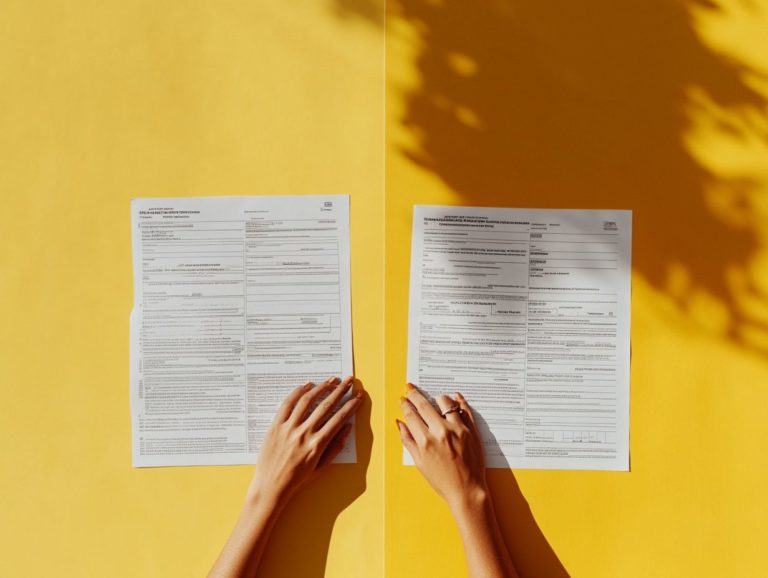How to Make the Most of Catch-Up Contributions
As retirement draws near, it s natural for individuals like you to seek ways to enhance your savings. Catch-up contributions present a valuable opportunity for those aged 50 and older to elevate their retirement accounts.
Let s explore how catch-up contributions can supercharge your retirement savings! This article covers who qualifies under IRS regulations, the benefits they offer, and effective strategies to make the most of your contributions, including tax-efficient planning, which means finding ways to reduce your tax bill legally.
You ll also find a discussion on potential risks, along with tips on how to seamlessly integrate these contributions into your financial plan.
Contents
- Key Takeaways:
- Understanding Catch-Up Contributions
- Eligibility for Catch-Up Contributions
- Benefits of Catch-Up Contributions
- Maximizing Catch-Up Contributions
- Potential Risks and Considerations
- Tips for Incorporating Catch-Up Contributions into Your Financial Plan
- Frequently Asked Questions on Retirement Topics
- What are catch-up contributions?
- Why should I consider catch-up contributions?
- What are the limits for catch-up contributions?
- How much can I contribute through catch-up contributions?
- When can I start making catch-up contributions?
- Do I need to notify my employer or retirement plan administrator to make catch-up contributions?
- Are catch-up contributions tax-deductible?
- What if I can’t afford to make catch-up contributions?
Key Takeaways:

- Catch-Up Contributions allow individuals aged 50 and above to contribute extra funds to their retirement accounts.
- Eligibility for Catch-Up Contributions is based on age and type of retirement plan.
- Making the most of Catch-Up Contributions can lead to increased retirement savings and reduced taxes, especially if you are in a lower tax bracket.
Understanding Catch-Up Contributions
Understanding catch-up contributions is essential for you as someone over the age of 50 who wants to strengthen your retirement savings and make the most of your retirement options. These contributions allow you to surpass the standard annual limits set by the IRS for various retirement accounts, such as 401(k)s, 403(b), traditional IRAs, Roth IRAs, and SIMPLE IRAs.
By implementing a thoughtful financial strategy, you can significantly enhance your retirement portfolio and enjoy valuable tax savings. This will guide you toward achieving your retirement goals and ensuring your retirement lifestyle is secure.
What are Catch-Up Contributions?
Catch-up contributions are your golden ticket if you’re 50 or older. They allow you to exceed the standard contribution limits in qualifying retirement accounts and maximize your nest egg.
These provisions are designed to boost your retirement savings during those pivotal years leading up to retirement, giving you the chance to set aside extra funds. In 2023, the catch-up contribution limit for 401(k) plans is $7,500. Combined with the standard limit of $22,500, this results in a total of $30,000, significantly enhancing your retirement savings potential. For IRAs, you can contribute an additional $1,000, bringing your maximum to $7,500 this year.
Looking ahead to 2024, these limits are set to increase, presenting even greater opportunities for significant tax-deferred growth and enhancing your retirement readiness. By taking advantage of these catch-up options, you enhance your retirement nest egg and enjoy substantial tax savings, as these contributions are often made pre-tax, effectively lowering your tax bill for the current year.
Eligibility for Catch-Up Contributions
Eligibility for catch-up contributions primarily depends on reaching the age of 50. This allows you to make additional contributions to your retirement plans, such as 401(k)s, 403(b)s, and IRAs.
This provision, established by IRS regulations, is designed to assist those approaching retirement in boosting their savings effectively and optimizing investment allocation.
By grasping the specific eligibility criteria, you can make the most of your contributions and fully leverage any employer matching programs available to you, ensuring you take advantage of all savings vehicles.
Who Can Make Catch-Up Contributions?
If you’re 50 or older, you can make catch-up contributions to your retirement accounts. This is a great way to boost your savings as you prepare for retirement.
Extra contributions can significantly increase your savings in plans like 401(k)s and IRAs. You’ll enjoy more funds for your retirement while maximizing your tax benefits!
By taking advantage of catch-up contributions, you can address any past savings shortfalls. This can provide you with greater financial security and support your retirement lifestyle. The chance to contribute extra funds not only strengthens your financial position but also enhances your money plan.
Don’t miss out on the chance to consult a financial advisor. They can help you create a winning money plan that aligns with your personal financial goals and retirement options.
Benefits of Catch-Up Contributions

Catch-up contributions present a wealth of advantages that can significantly elevate your retirement savings. This is especially useful if you may have under-contributed in your earlier years. It allows for greater tax-friendly growth.
These provisions allow you to surpass the standard contribution limits. They empower you to enhance your retirement portfolio while optimizing tax deductions and enjoying tax-deferred growth.
Embracing this strategy is crucial for reaching your long-term retirement goals. It helps secure a comfortable lifestyle in your golden years, allowing you to enjoy your retirement income.
Advantages for Retirement Savings
The advantages of catch-up contributions extend beyond simply enhancing your retirement savings. They offer significant tax benefits and opportunities to boost your retirement income and secure your financial future.
For individuals aged 50 and over, these contributions enable you to set aside extra funds in your 401(k) or IRA accounts, including SIMPLE IRAs. This can substantially elevate your overall savings as you near retirement.
These contributions lower your taxable income for the current year. They also allow for tax-deferred growth over time, enhancing your overall financial health.
This dual advantage empowers you to secure a more stable financial future. It significantly increases your retirement income and strengthens your overall financial security.
Maximizing Catch-Up Contributions
Maximizing your catch-up contributions requires strategic planning and a solid understanding of your unique financial goals and retirement choices. Implementing effective strategies like diversifying your investment mix and fully engaging in employer contributions can boost your retirement savings and optimize your investment allocation.
This proactive approach not only enhances your overall retirement portfolio but also ensures alignment with your long-term retirement aspirations and financial objectives.
Strategies for Making the Most of Catch-Up Contributions
Implementing effective strategies for catch-up contributions can significantly enhance your retirement savings and align with your broader financial goals for a secure future.
Prioritizing smart tax planning helps you maximize the benefits of these additional contributions, allowing for even greater growth over time and an increased contribution potential.
Choosing the right retirement accounts, or savings accounts specifically for retirement, is equally crucial. Each type, including 401(k)s and 403(b)s, comes with different tax implications and withdrawal options that can impact your overall financial health.
Regularly consulting with a financial advisor is essential. It ensures that your contributions are tailored to your unique situation, helping you fully understand the implications and benefits of your decisions, including potential tax deductions.
By combining these strategies, you have the power to build a strong plan that boosts your savings and instills confidence in achieving your long-term retirement objectives and fulfilling your retirement goals.
Potential Risks and Considerations
While catch-up contributions can significantly enhance your retirement savings, it’s essential to evaluate the potential risks and factors that may influence your financial strategy and overall retirement planning.
Factors to Keep in Mind

When considering catch-up contributions, several factors deserve your attention, including your individual financial goals, investment allocation, and overall retirement planning. These are crucial for optimizing your savings strategy.
These elements ensure that your savings strategy is effective and in sync with your future needs and retirement resources. By evaluating your personal financial objectives, you can determine the precise amount you need to save to fulfill your retirement aspirations and enjoy an ideal retirement lifestyle.
Grasping the right investment allocation is key to maximizing the growth potential of your catch-up contributions. This thoughtful approach boosts your chances of enjoying a comfortable retirement and weaves those contributions seamlessly into a comprehensive financial plan.
This ensures that every element works together in harmony for your long-term success and retirement readiness.
Tips for Incorporating Catch-Up Contributions into Your Financial Plan
Incorporating catch-up contributions into your financial plan demands careful evaluation of your retirement goals, current savings, and overall financial strategy to optimize your growth.
See catch-up contributions as a golden opportunity to supercharge your retirement savings! You can take proactive measures to strengthen your retirement portfolio and safeguard your financial future for yourself and your family.
How to Plan and Budget for Catch-Up Contributions
Planning and budgeting for catch-up contributions requires meticulous evaluation of your current financial resources alongside your future retirement needs, including all viable savings vehicles.
This process starts with a comprehensive review of your existing retirement accounts. Ensure that every contribution is accounted for and any funding gaps are clearly identified to enhance your overall financial strategy.
Once this assessment is complete, establish clear financial goals to determine how much additional savings you’ll need to cover any shortfalls. Reflecting on your investment allocation may also be necessary to align more closely with these objectives.
This step not only enhances the potential of your catch-up contributions but also ensures that your overall retirement strategy remains robust and effective, paving the way for a more secure financial future.
Frequently Asked Questions on Retirement Topics
What are catch-up contributions?
Catch-up contributions are additional contributions that individuals over the age of 50 can make to their retirement accounts to help boost their savings for retirement.
Why should I consider catch-up contributions?
Considering catch-up contributions can significantly improve your retirement savings, allowing you to secure a more comfortable future.
What are the limits for catch-up contributions?
The contribution limits can vary based on the type of retirement account, so it s important to check the IRS guidelines for the most current limits.
How much can I contribute through catch-up contributions?

The maximum catch-up contribution depends on your retirement account type. For 401(k) plans, the limit for 2021 is $6,500, while for IRAs, it’s $1,000.
When can I start making catch-up contributions?
You can begin making catch-up contributions in the year you turn 50. For instance, if you turn 50 in 2021, you can contribute for that tax year.
Do I need to notify my employer or retirement plan administrator to make catch-up contributions?
Yes, inform your employer or plan administrator of your intent to make catch-up contributions. This ensures proper adjustments to your contributions.
Are catch-up contributions tax-deductible?
Absolutely! Catch-up contributions are tax-deductible, just like regular contributions. This can help lower your taxable income and reduce your overall tax bill.
What if I can’t afford to make catch-up contributions?
If finances are tight, focus on making regular contributions first. Remember, even small increases in your contributions can lead to significant benefits over time!






